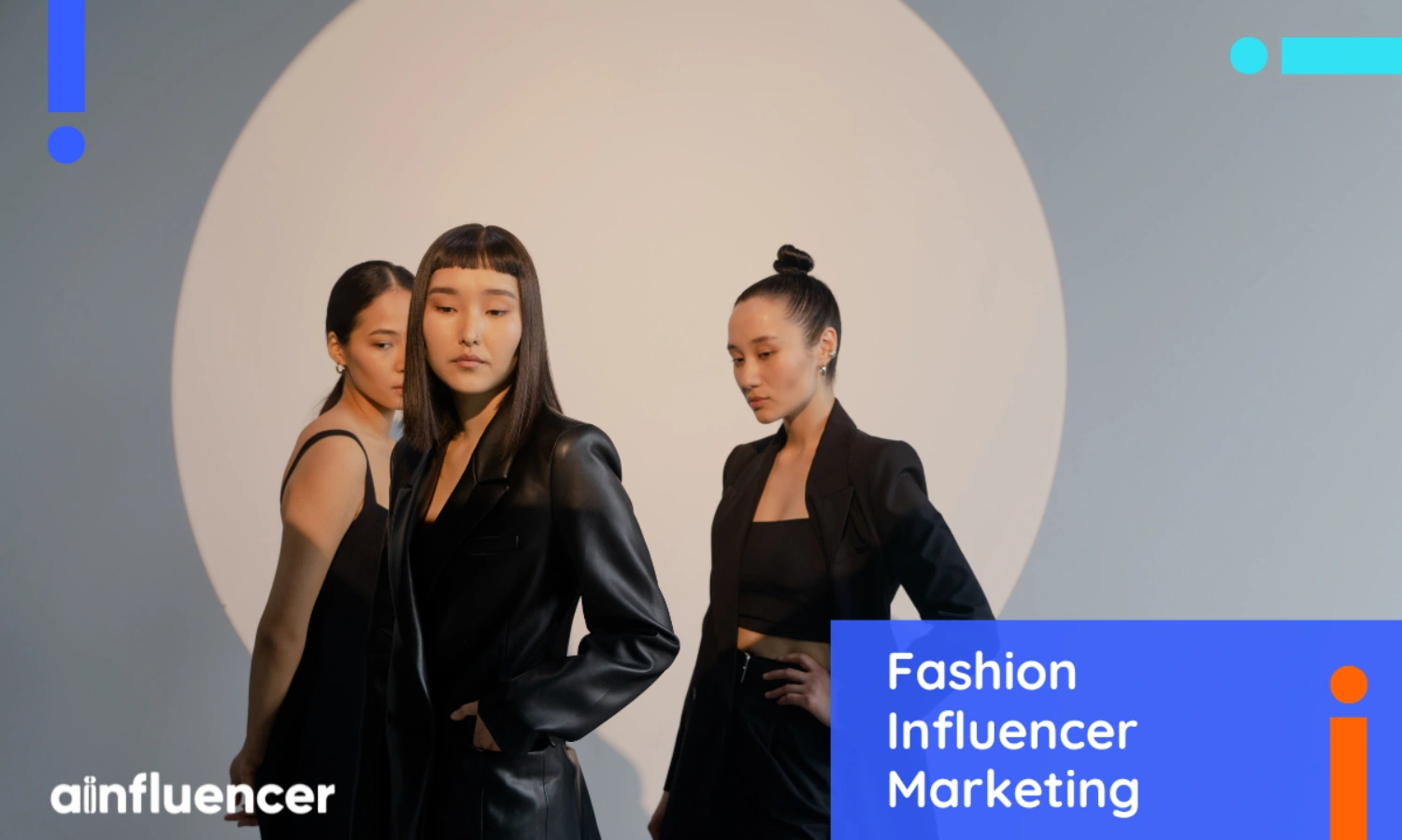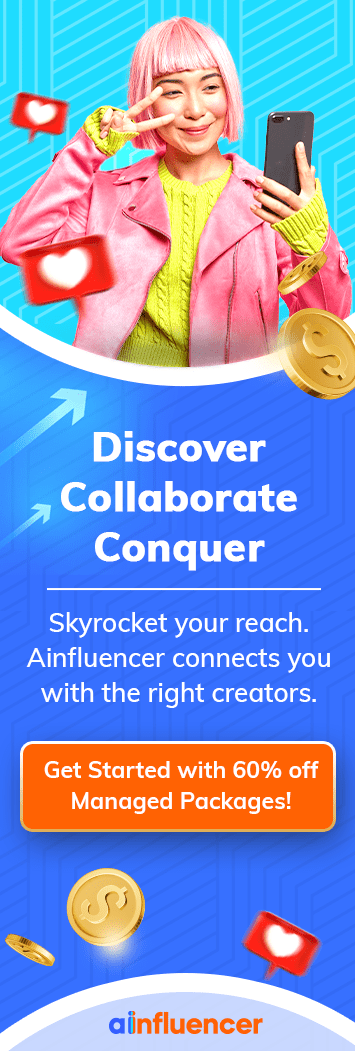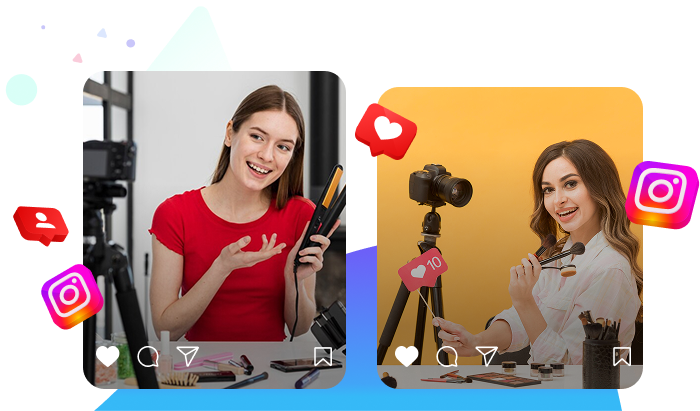Fashion influencer marketing has become one of the most effective ways for fashion brands to connect with modern audiences. By partnering with popular social media creators, brands can showcase clothing, accessories, and lifestyle products in a genuine and relatable way.
The fashion and beauty industries are leading this trend with the help of the best influencer marketing platforms, which can help them find and collaborate with top influencers in this niche. With the right strategy, influencer marketing can increase brand awareness, build strong customer relationships, and drive meaningful sales.
In this guide, we will walk you through everything you need to know — including what fashion influencer marketing is, how to create an effective strategy, and the common mistakes to avoid. We will also share tips on finding the perfect influencer for your brand.
Let’s get started!
Understanding Fashion Influencer Marketing: A Fresh Take
In today’s social-media-driven world, fashion brands are no longer relying solely on glossy magazine ads or billboards to reach their audience. Instead, they are tapping into the authentic voices of influencers.
Fashion influencer marketing is the strategy where brands collaborate with online personalities—bloggers, Instagrammers, YouTubers, TikTokers, and celebrities—to showcase their products in a relatable, engaging way.
Rather than presenting a scripted advertisement, brands allow fashion influencers to seamlessly weave their products into everyday content—whether it’s a chic outfit of the day (OOTD) post, a YouTube shopping haul, or a TikTok styling challenge.
These influencers already have the trust and attention of their followers, making their endorsements feel more genuine and powerful than traditional ads.
Influencer marketing effectively bridges the gap between brands and consumers, offering style inspiration that feels personal and authentic rather than commercialized.
How Fashion Influencer Campaigns Work
The heart of fashion influencer marketing lies in authentic partnerships. Here’s how it usually unfolds:
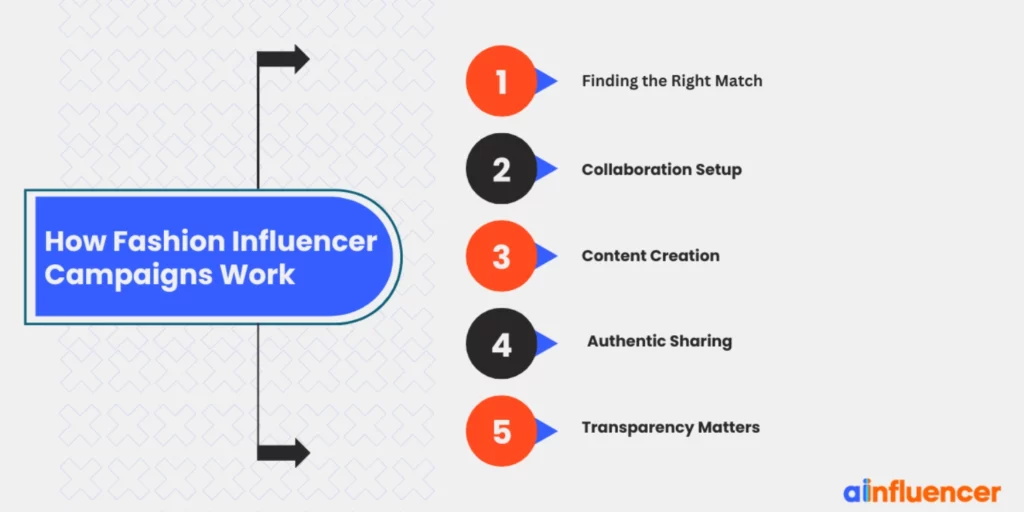
- Finding the Right Match: Brands identify influencers whose personal brand, style, and audience align with their own image and goals.
- Collaboration Setup: The brand offers something in return for promotion—whether that’s free merchandise, payment, affiliate deals, or special experiences.
- Content Creation: Influencers produce engaging content featuring the brand’s clothing, accessories, or shoes. This could be an Instagram carousel, a TikTok try-on video, or even behind-the-scenes footage at a fashion show.
- Authentic Sharing: Influencers post their content to their audience, tagging the brand and often using branded hashtags to build campaign momentum.
- Transparency Matters: To maintain trust and comply with advertising guidelines, influencers disclose sponsored posts using labels like #ad or #sponsored.
The beauty of this approach? It doesn’t feel like marketing—it feels like trusted style advice from a friend.
Why Influencers Are Essential for Fashion Brands
Old-school advertising methods struggle to captivate today’s digital natives. Millennials and Gen Z consumers are deeply influenced by what they see on Instagram, YouTube, and TikTok.
Trends now emerge in real-time—often led by influencers rather than designers or magazines.
Brands turn to influencers because:
- They build real connections: Followers trust influencer recommendations far more than traditional ads.
- They create lifestyle-driven content: Influencers show how products fit into real life, making it easier for consumers to picture themselves wearing or using the brand.
- They drive engagement: Influencer content typically generates higher interaction rates than brand-produced content.
- They offer valuable assets: Brands can repurpose influencer content across their own social media, websites, and ads for even broader reach.
Fashion influencer marketing offers brands an unbeatable combination of trust, creativity, relevance, and exposure. When executed thoughtfully, it turns followers into fans—and fans into loyal customers.
Why Fashion Brands Are Turning to Fashion Influencer Marketing: Key Benefits
Fashion Influencer Marketing has exploded in the fashion world—and for good reason. It’s not just a passing trend; it’s a strategy that delivers real results. Here’s why:
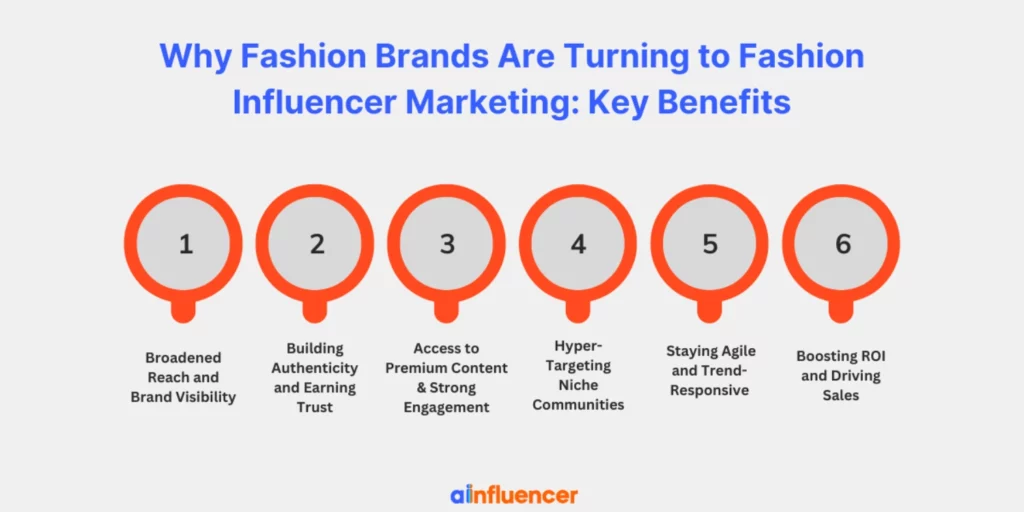
1. Broadened Reach and Brand Visibility
One influencer post can introduce your brand to thousands, even millions, of new potential customers.
Take the American fashion influencers as an example. When they tag your fashion label in an outfit post, their loyal followers immediately notice.
Some will click through out of curiosity, others may start following you, and some might make a purchase on the spot.
2. Building Authenticity and Earning Trust
Modern consumers value authenticity—and influencers provide it. Unlike traditional celebrity endorsements, influencers offer relatable and trustworthy recommendations. Micro and macro influencers engage with their communities daily, answering questions and offering styling tips.
Their genuine interaction lends credibility to your brand and positions your products in an aspirational, yet relatable, light.
3. Access to Premium Content & Strong Engagement
Influencers aren’t just promoters—they’re talented content creators. From stunning lookbooks on Instagram to viral try-on hauls on TikTok, influencers know how to showcase fashion in ways that captivate modern audiences.
4. Hyper-Targeting Niche Communities
Fashion is deeply personal and niche-driven. Whether it’s sustainable streetwear, high-end couture, or plus-size vintage, there’s a specific audience for every style—and influencers are often at the heart of these communities. Working with niche or micro-influencers allows brands to directly target these passionate audiences.
5. Staying Agile and Trend-Responsive
Fashion trends shift at lightning speed—and influencers are usually the first to spot what’s hot. By working with them, brands can quickly align themselves with emerging styles or viral moments.
Need to promote a capsule collection or highlight a flash sale? Influencers can create and post content within days, helping your brand ride trending waves while they’re still fresh.
6. Boosting ROI and Driving Sales
Ultimately, what matters most are results—and influencer marketing continues to prove its value. With the right partnerships, brands often see increased sales, higher website traffic, and stronger social media growth.
When an influencer-driven post goes viral, the impact can be instant: sell-outs, waiting lists, and long-term brand loyalty. With fashion influencer marketing, your return on investment can be exponential.
Successful Fashion Influencer Marketing Campaigns
Learning from successful campaigns can refine your approach. Here are a few standout examples:
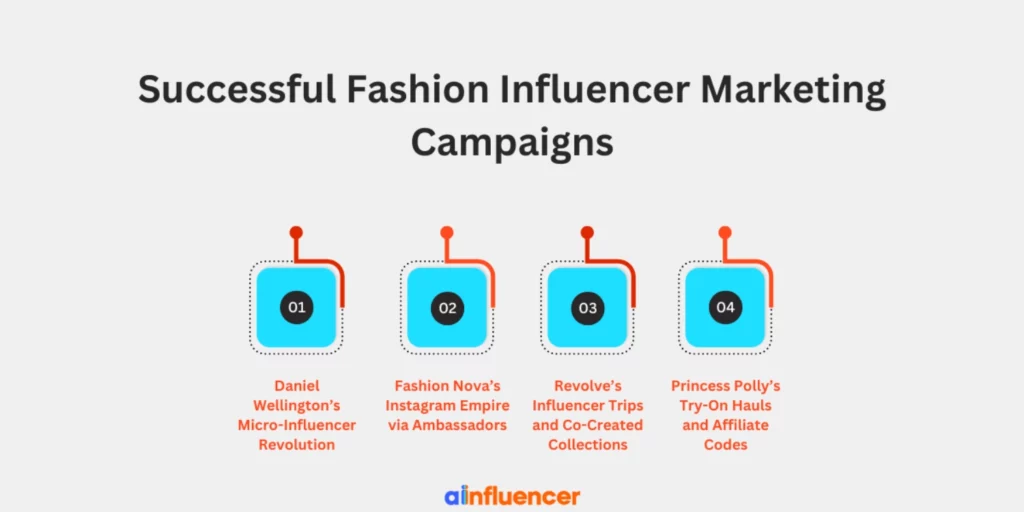
- Daniel Wellington’s Micro-Influencer Revolution: Daniel Wellington thrived by partnering with thousands of micro-influencers. Instead of traditional ads, they gifted watches and provided discount codes. This strategy created a buzz, making the brand a global sensation. Their success highlighted how a network of smaller influencers can drive both awareness and direct sales.
- Fashion Nova’s Instagram Empire via Ambassadors: Fashion Nova leveraged influencers and celebrities like Cardi B and Kylie Jenner to build an Instagram empire. By reposting influencer content, they created a continuous stream of engaging user-generated posts, resulting in over 21 million Instagram followers. This approach proved that volume and user-generated content can elevate a brand’s visibility significantly.
- Revolve’s Influencer Trips and Co-Created Collections: Revolve elevated influencer marketing by integrating influencers into its brand. From #RevolveAroundTheWorld trips to co-created clothing lines, they transformed influencers into brand advocates. This resulted in massive engagement and helped Revolve grow into a billion-dollar company.
- Princess Polly’s Try-On Hauls and Affiliate Codes: Princess Polly achieved rapid global expansion through “try-on haul” videos on platforms like YouTube and TikTok. They paired these with affiliate programs, allowing influencers to earn commissions on sales made through their codes. This strategy boosted Princess Polly’s U.S. presence, with many customers discovering the brand via influencers.
How to Run a Successful Fashion Influencer Campaign
A successful influencer marketing campaign in fashion begins with careful planning, but it’s the execution that really drives results. To help you navigate this process, here are some key best practices to follow:
- Set Clear Expectations: Before the campaign, ensure alignment on deliverables, deadlines, key messages, and disclosure requirements. A well-crafted campaign brief helps avoid confusion and keeps things on track.
- Balance Creative Freedom with Brand Guidelines: Allow influencers creative control while maintaining your brand’s aesthetic. Providing a mood board or example content can help, but trust influencers to showcase the product in their style. Authentic content often performs best.
- Ensure FTC Compliance and Transparency: Influencers must disclose partnerships clearly. Remind them to include disclosures like “#ad” or similar phrases. Transparency builds trust with audiences, making the campaign more effective.
- Engage and Amplify Content: Engage with influencer posts by liking, commenting, or sharing on your brand’s channels. Cross-promotion and timely responses in the comments can boost visibility and engagement.
- Monitor Performance in Real Time: Track campaign performance with UTM links or dashboards. If something underperforms, make adjustments like reminding influencers to post at optimal times or reposting missed content.
- Provide Tracking Links or Promo Codes: Set up unique tracking links or promo codes for each influencer to measure ROI. Ensure influencers know how to use them and test them to verify they work.
- Respect Creative Boundaries: Avoid excessive micromanaging. If the content aligns with your goals, let influencers stay authentic. Build a positive, ongoing relationship rather than focusing on minor revisions.
- Measure and Learn: After the campaign, analyze the results. Evaluate ROI, influencer performance, and content engagement. Use these insights to improve future campaigns.
Latest Trends in Fashion Influencer Marketing (2024–2025)
The world of fashion influencer marketing is always shifting. Here are the top trends to keep an eye on:
1. Micro and Nano-Influencers Are on the Rise
Smaller influencers are taking center stage. Brands are turning to micro (10k–100k followers) and nano-influencers (<10k) for their highly engaged, loyal communities. These influencers often bring the best results, allowing brands to reach niche markets while stretching marketing budgets.
2. Short-Form Video is King
Platforms like TikTok, Instagram Reels, and YouTube Shorts have made short-form video the go-to format. Fashion brands love using influencers to create quick, catchy videos like styling challenges or unboxing montages. Short videos are a fun, engaging way to promote fashion, and they’re not going anywhere.
3. Authenticity Over Perfection
Audiences, especially Gen Z, crave realness. Influencers are showing more unfiltered, behind-the-scenes moments rather than polished magazine-style content. This authenticity builds trust, and brands are adapting by encouraging more genuine, transparent content from influencers.
4. Live Shopping is Growing
Live shopping is booming in Western markets, thanks to platforms like Instagram and TikTok. Influencers host live sessions where they showcase products, answer questions, and allow viewers to shop in real-time. Expect this trend to keep growing as tech improves.
5. Virtual Influencers and AI
Virtual influencers (like CGI characters) are making waves, with some brands even using AI for content creation. While still niche, this trend is growing, offering a futuristic way for brands to engage audiences. However, human influencers are still needed for authenticity.
6. Long-Term Partnerships Are Key
Instead of one-off campaigns, brands are opting for long-term influencer relationships. This helps build stronger, more authentic connections between influencers and their audiences. Examples include exclusive brand ambassador roles and creative partnerships.
7. Social Commerce & Affiliate Marketing
Shopping features on social media are making influencer marketing more seamless. Platforms like Instagram and TikTok allow influencers to tag products, making it easy for followers to buy directly from their posts. Brands are using fashion affiliate programs to turn influencers into a powerful sales force.
8. Diversity and Inclusivity Matter
Consumers want to see diversity in the influencers they follow. Fashion brands are expanding their influencer networks to reflect a wide range of body types, ethnicities, ages, and styles, helping them connect with more customers.
9. Data-Driven Influencer Selection
Brands are using fashion influencer marketing platforms to choose the best influencers, analyzing metrics like audience engagement, demographics, and past performance. Tools like AI-powered platforms make it easier to find the right fit for campaigns, helping brands scale more effectively.
Staying ahead of these trends can give your influencer strategy an edge. The key is to adapt and experiment, trying out new content formats and tools to create authentic, engaging campaigns.
How to Find and Collaborate with Fashion Influencers?
Managing influencer campaigns in the fashion industry can be time-consuming, expensive, and hit-or-miss—unless you’re using Ainfluencer, a 100% free, DIY influencer marketplace built to simplify and supercharge your marketing strategy.
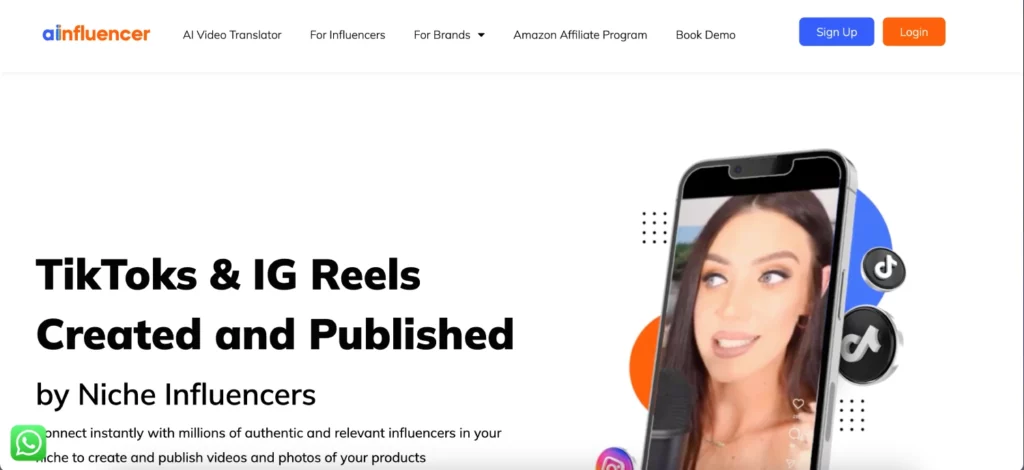
Here are some services offered by Ainfluencer:
- No Fees, No Subscriptions—Truly Free,
- AI-Powered Influencer Discovery,
- Multi-Platform Talent Pool,
- Secure Escrow Payments,
- Reach Global Fashion Audiences,
- Transparent Influencer Profiles,
- Campaign Management Dashboard,
- Real-Time Campaign Analytics,
- E-Commerce Integrations,
- Built-In Affiliate Tools,
- Optional Managed Services,
- Fashion Marketing Support & Inspiration.
Ainfluencer takes the stress out of influencer marketing. Create your free account, explore fashion influencers, and launch your next campaign in just minutes. No contracts. No fees. Just results.
Join Ainfluencer for Free!Conclusion
Fashion influencer marketing is a powerful and effective strategy for brands, offering the ability to connect authentically with audiences and drive both engagement and sales.
To succeed, it’s crucial to strategically choose influencers who align with your brand’s values and goals, offer creative freedom within a framework, and measure campaign success through data analytics. Stay ahead of trends by embracing short-form videos, micro-influencers, and live shopping events, while fostering genuine partnerships with influencers to maintain authenticity.
FAQs
To begin, define your goals (e.g., increasing brand awareness or driving sales). Choose influencers who align with your target audience. Start with micro-influencers, who tend to have highly engaged followers. Provide them with products to feature, along with clear campaign guidelines. Monitor and analyze the campaign’s results to optimize future efforts. If you’re also selling on platforms like Amazon, consider using tools like AlgoRift.ai to streamline influencer outreach, manage affiliate links, and track campaign results more effectively.
Costs can vary depending on the influencer’s reach. Micro-influencers typically charge between $500–$2,000 per post, while influencers with a larger following or celebrities can demand $10,000+. Some campaigns can also be based on affiliate commissions, where influencers earn a percentage of sales they generate.
Micro-influencers tend to have a more engaged and niche following, which can lead to higher engagement rates at a lower cost. Celebrity influencers offer a broader reach, but may come with a higher price tag and less direct engagement. For most brands, working with micro-influencers offers a more targeted and cost-effective approach.
Instagram, TikTok, and YouTube are the best platforms for fashion influencer marketing. Instagram is ideal for high-quality visual content and brand storytelling, TikTok is great for viral trends and short-form videos, and YouTube allows influencers to produce long-form content that offers deeper engagement with audiences.
